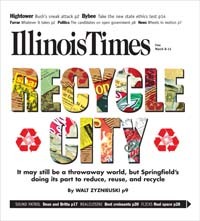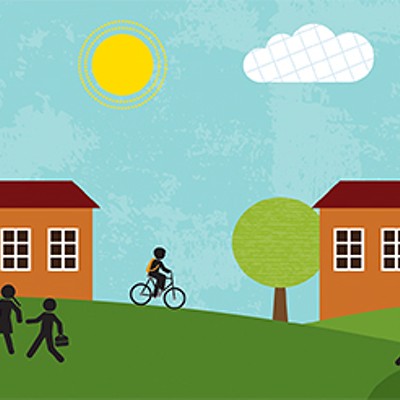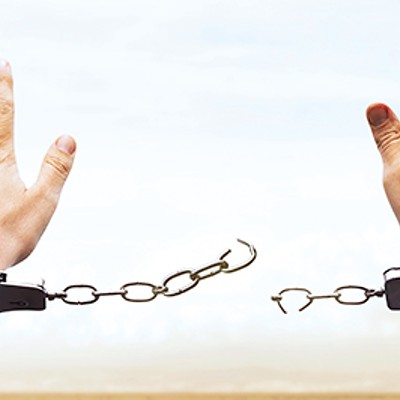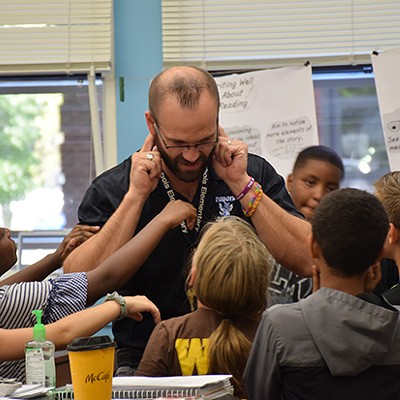Recycle city
It may still be a throwaway world, but Springfield’s doing its part to reduce, reuse, and recycle

[
{
"name": "Air - MedRect Combo - Inline Content 1",
"component": "11490391",
"insertPoint": "3",
"requiredCountToDisplay": "1",
"parentWrapperClass": "fdn-ads-inline-content-block"
},{
"name": "Air - MedRect Combo - Inline Content 2",
"component": "11490392",
"insertPoint": "7",
"requiredCountToDisplay": "5",
"parentWrapperClass": "fdn-ads-inline-content-block"
},{
"name": "Air - MedRect Combo - Inline Content 3",
"component": "11490393",
"insertPoint": "12",
"requiredCountToDisplay": "9",
"parentWrapperClass": "fdn-ads-inline-content-block"
}
]
Untitled Document
Twenty-eight years ago, fresh out of college, I
arrived in Springfield to begin my professional career. Living by myself, I
didn’t really generate much trash, and the three R’s —
reduce, reuse, and recycle — weren’t common or trendy around
town then or, for that matter, around the country. In fact, the only item I
remember recycling regularly was newsprint, which I took down to the
Salvation Army.
My first experience with recycling came when I was
growing up in Chicago. My friends and I used to take a shopping cart or
burlap bag to the Kennedy Expressway, where we’d hunt for returnable
glass bottles along the highway embankment. Our reward for picking up the
“heated sand products” was the few cents we received for the
deposit, which we’d use to buy candy or soda at our corner
neighborhood store. Life was good — though, thinking back, I realize
that we were lucky not to get zinged by flying bottles tossed from the
passing cars.
Later, at my first real job, at an Osco Drug, one of
my duties was to take empty cardboard boxes, flatten them, and insert them
into the cardboard baler to be compressed. I would twist steel wire around
the cardboard, then push the bale out by the loading dock to be picked up.
I never knew where the cardboard was being taken, but
I assumed that we were saving trees — and the environment —
because it wasn’t going into the Dumpster.
Today when you take a drive behind any grocery store
or strip mall around town, you’ll still see baled cardboard waiting
to be picked up for recycling. Cardboard recycling continues to thrive, but
it’s a different story for glass, including returnable glass bottles.
My recycling efforts have broadened while living in
Springfield for the past quarter-century. The city, supported by state and
federal initiatives, and local recycling companies have pushed recycling to
the forefront. Today, like many Springfieldians, I keep a blue bin in my
garage, fill it religiously with recyclable materials, and take it out once
a week for my local trash hauler.
So, how far has Springfield come with the recycling
bandwagon, what can be recycled today, how much do we recycle, and, most
important, where does our recyclable “stuff” go?
Wynne Coplea, manager of the city’s Division of
Waste and Recycling, estimates that 10,000 to 11,000 households in
Springfield, or about a third of those eligible, participate in the
city’s blue-bin recycling program.
“This is par with the national average,”
she says.
Coplea, who has been in her current position with the
city since December 1999, has been involved with community recycling
efforts for 20 years, starting as a volunteer at King Harvest Co-op, then
located at Camp Lincoln. Between 1992 and 1997, Coplea served as the
solid-waste coordinator for Sangamon County, where she helped found our
local Earth Awareness Day, with the late Roberta Merriam, the city’s first
solid-waste coordinator. Now in its 15th year, Earth Awareness Day will be
held at the Expo Building, on the state fairgrounds, on April 28.
Today Coplea serves as a board member and chairman of
public education for the Illinois Recycling Association. Over the past year
she has given presentations to 29 school or service clubs, three guest
lectures at the University of Illinois at Springfield, other public
gatherings and recycling functions.
Coplea has a wealth of knowledge on recycling topics,
is enthusiastic about the subject, and is quite proud of her recycling
worms (more on those later) — and, as it turns out, she also has
something in common with me: We both set up recycling programs (paper,
cardboard, aluminum cans) at our places of employment: Coplea at Camp
Lincoln, I at the CWLP Power Plant complex.
With various recycling efforts going on today, I often wonder if recycling is really good for the environment. Are all recyclables really recycled? Do some end up in the landfill? Where do the recyclable materials go to be reused/reprocessed? First, a little background: The city of Springfield requires that city residents use a private waste hauler for garbage removal. As part of the monthly fee, the waste hauler offers the blue-bin recycling service. In addition, about 50 cents of the fee goes to the city, generating about $180,000 a year that’s used, Coplea says, for various educational recycling brochures and pamphlets, new bins, the springtime yard-waste pickup, residential large-item pickup, used-tire and clear-glass recycling, and electronics recycling. Have you ever wondered what to do with that broken or obsolete computer, VCR, or fax machine that’s been sitting in your basement gathering dust? Well, the 50-cent fee helps support the free electronics-recycling program at BLH Computers in Springfield. Televisions also are recycled for a fee at this facility. The city’s been fairly aggressive in recycling initiatives. For example, in 2001, with proceeds from a state grant, the city set up 114 public on-street recycling containers, Coplea says. The containers, located near curbs at many downtown locations, are made of 100 percent recycled No. 2 plastic and receive about 180 to 200 pounds of recyclable material a week, she says. But the real haul comes from residential pickup. Springfield residents rely on four garbage collection companies: Allied Waste Systems, Illini Disposal, Lake Area Disposal, and Waste Management. Each residential waste hauler is required to offer recycling. Our current blue-bin recycling program allows us to recycle paper (newsprint, envelopes, magazines, cereal boxes), clear glass, No. 1 through No. 7 plastics (except No. 6 plastic), and aluminum and tin cans. So where do these companies take recyclable materials? Allied Waste, Illini Disposal, and Waste Management take recyclables to F & W Resources, on Terminal Avenue; Lake Area uses its facility on South Sixth Street, Coplea says. Both locations — which together handled about 15,000 tons of materials in 2006, according to Coplea — are also open to the public for drop-off recycling, 24/7. You can also take your corrugated cardboard to the recycling facilities. What happens after the materials go to one of these two facilities? I recently met with Lake Area Recycling general manager Don Crenshaw and his wife and office manager, Sheri Crenshaw, to learn about their operation. Don is the third generation of Crenshaws in the disposal business, which started in 1932. The recycling division has been in business since 1996. Here’s a snapshot of their operations: Lake Area Recycling offers drop-off Dumpsters for cardboard, plastics, paper, and aluminum and tin cans. Other metals, including copper and brass, can be weighed and sold inside. Inside the white “metals” building is a can condenser that smashes the cans to yield a compressed briquette that weighs 40 to 50 pounds. These briquettes are stacked into large bales. Plastics, paper, cardboard, and cans also go into the second building known as the “cardboard” building. There the plastics are sorted into three categories, then baled. Paper, cardboard, and tin cans go into a conveyor and baler, where they are compressed. Aluminum bales weigh 800 pounds, cardboard bales an average of 2,000 pounds, and paper bales as much as 1,500 pounds. A third building, known as the “paper” building, has a newer paper conveyor and baler.
These materials are purchased by various brokers, Crenshaw says. For example, brewing giant Anheuser-Busch buys aluminum, which it recycles into new beer cans. Other St. Louis businesses buy Lake Area’s paper, cardboard, and clear glass; plastics go to a facility in Quincy. In 2006, Lake Area Recycling kept more than 6,700 tons of material from going to landfills while keeping 20 people employed.
I have been recycling since I had my blue bin delivered to my first home. Now I’ve become so recycling-conscious that on occasion I find myself going through our garbage at home to remove stuff my wife has nonchalantly thrown away. She thinks “garbage,” I think “reuse and recycle.”
Can we recycle everything from our household waste stream to reduce the total amount we send to the landfill? Not likely. Can we reduce our waste stream by recycling many common household goods? Yes. Can we reduce the amount of garbage we generate? Yes — with a little planning, such as buying products in bulk and looking for goods with less packaging. One weekend during a recent winter thaw, I decided to do my part for recycling and the environment, so I went about picking up aluminum cans at a major crossroads near my house. In just a short time I filled a midsize plastic bag and took my treasure home. I decided to count and weigh the cans to see how I did. My tally: 118 cans — nearly 5 pounds. Not too bad. The next day, unfortunately — or fortunately for the next person who picks them up — the road was littered with more empty cans. It’s hard for our society to break away from our throwaway mentality, although true believers such as Wynne Coplea are doing a good job trying to educate us by promoting the value of the three R’s. Oh yes, about Coplea’s recycling worms: The city official keeps a blue plastic container in her office — filled with rich humus and topped with a layer of soil and shredded paper — that is home to a handful of red wiggler worms. Coplea brings vegetable table scraps from home and mixes them in the soil, and in no time the meal is devoured. Mother Nature, says Coplea with a smile, recycles well, too.
Walt Zyznieuski of Springfield has written about the Civilian Conservation Corps, old Interurban railroad, and other subjects for Illinois Times.
RECYCLING FACTS
In the United States, 374 aluminum-can beverages are consumed per person per year.
It takes 95 percent less energy to make aluminum by recycling it than by producing it from its natural ore, bauxite. It costs less, too.
The average American uses 589 pounds of paper each year. As a nation, we consume 850 million trees annually.
Seventeen trees are saved when one ton (2,000 pounds) of newspaper is recycled.
Every year, Americans throw away enough office and writing paper to build a wall 12 feet high from New York to Los Angeles.
For every glass bottle recycled, we save enough energy to power a 100-watt light bulb for four hours.
Americans throw away 2.5 million plastic bottles every hour.
No. 1 and No. 2 plastics are being recycled into carpeting, clothing, luggage, lumber, shoes, park benches, picnic tables, playground equipment, flowerpots, Frisbees, and new drink bottles.
Source: “Room to Room: A Household Guide to Recycling and Reuse for Springfield Residents,” Springfield Division of Waste and Recycling, fall 2006
FOR MORE INFORMATION
For additional information on recycling, contact Wynne Coplea, manager of waste and recycling for the city of Springfield, 217-789-2366; F & W Resources, 217-525-1206; Lake Area Recycling, 217-522-9271; BLH Computers, 217-585-1580; Evans Recycling, 217-391-0886; Mervis Iron & Supply, 217-753-1492; or Springfield Iron & Metal, 217-744-7131.
The city offers excellent brochures on recycling, including “Room to Room: A Household Guide to Recycling and Reuse,” “Home Composting,” “Curbside Recycling,” “Yard Waste Disposal,” and “Wondering What to Do with All That Trash, Waste and Recycling Guide.” Blue bins should be requested from your local waste hauler.
With various recycling efforts going on today, I often wonder if recycling is really good for the environment. Are all recyclables really recycled? Do some end up in the landfill? Where do the recyclable materials go to be reused/reprocessed? First, a little background: The city of Springfield requires that city residents use a private waste hauler for garbage removal. As part of the monthly fee, the waste hauler offers the blue-bin recycling service. In addition, about 50 cents of the fee goes to the city, generating about $180,000 a year that’s used, Coplea says, for various educational recycling brochures and pamphlets, new bins, the springtime yard-waste pickup, residential large-item pickup, used-tire and clear-glass recycling, and electronics recycling. Have you ever wondered what to do with that broken or obsolete computer, VCR, or fax machine that’s been sitting in your basement gathering dust? Well, the 50-cent fee helps support the free electronics-recycling program at BLH Computers in Springfield. Televisions also are recycled for a fee at this facility. The city’s been fairly aggressive in recycling initiatives. For example, in 2001, with proceeds from a state grant, the city set up 114 public on-street recycling containers, Coplea says. The containers, located near curbs at many downtown locations, are made of 100 percent recycled No. 2 plastic and receive about 180 to 200 pounds of recyclable material a week, she says. But the real haul comes from residential pickup. Springfield residents rely on four garbage collection companies: Allied Waste Systems, Illini Disposal, Lake Area Disposal, and Waste Management. Each residential waste hauler is required to offer recycling. Our current blue-bin recycling program allows us to recycle paper (newsprint, envelopes, magazines, cereal boxes), clear glass, No. 1 through No. 7 plastics (except No. 6 plastic), and aluminum and tin cans. So where do these companies take recyclable materials? Allied Waste, Illini Disposal, and Waste Management take recyclables to F & W Resources, on Terminal Avenue; Lake Area uses its facility on South Sixth Street, Coplea says. Both locations — which together handled about 15,000 tons of materials in 2006, according to Coplea — are also open to the public for drop-off recycling, 24/7. You can also take your corrugated cardboard to the recycling facilities. What happens after the materials go to one of these two facilities? I recently met with Lake Area Recycling general manager Don Crenshaw and his wife and office manager, Sheri Crenshaw, to learn about their operation. Don is the third generation of Crenshaws in the disposal business, which started in 1932. The recycling division has been in business since 1996. Here’s a snapshot of their operations: Lake Area Recycling offers drop-off Dumpsters for cardboard, plastics, paper, and aluminum and tin cans. Other metals, including copper and brass, can be weighed and sold inside. Inside the white “metals” building is a can condenser that smashes the cans to yield a compressed briquette that weighs 40 to 50 pounds. These briquettes are stacked into large bales. Plastics, paper, cardboard, and cans also go into the second building known as the “cardboard” building. There the plastics are sorted into three categories, then baled. Paper, cardboard, and tin cans go into a conveyor and baler, where they are compressed. Aluminum bales weigh 800 pounds, cardboard bales an average of 2,000 pounds, and paper bales as much as 1,500 pounds. A third building, known as the “paper” building, has a newer paper conveyor and baler.
These materials are purchased by various brokers, Crenshaw says. For example, brewing giant Anheuser-Busch buys aluminum, which it recycles into new beer cans. Other St. Louis businesses buy Lake Area’s paper, cardboard, and clear glass; plastics go to a facility in Quincy. In 2006, Lake Area Recycling kept more than 6,700 tons of material from going to landfills while keeping 20 people employed.
I have been recycling since I had my blue bin delivered to my first home. Now I’ve become so recycling-conscious that on occasion I find myself going through our garbage at home to remove stuff my wife has nonchalantly thrown away. She thinks “garbage,” I think “reuse and recycle.”
Can we recycle everything from our household waste stream to reduce the total amount we send to the landfill? Not likely. Can we reduce our waste stream by recycling many common household goods? Yes. Can we reduce the amount of garbage we generate? Yes — with a little planning, such as buying products in bulk and looking for goods with less packaging. One weekend during a recent winter thaw, I decided to do my part for recycling and the environment, so I went about picking up aluminum cans at a major crossroads near my house. In just a short time I filled a midsize plastic bag and took my treasure home. I decided to count and weigh the cans to see how I did. My tally: 118 cans — nearly 5 pounds. Not too bad. The next day, unfortunately — or fortunately for the next person who picks them up — the road was littered with more empty cans. It’s hard for our society to break away from our throwaway mentality, although true believers such as Wynne Coplea are doing a good job trying to educate us by promoting the value of the three R’s. Oh yes, about Coplea’s recycling worms: The city official keeps a blue plastic container in her office — filled with rich humus and topped with a layer of soil and shredded paper — that is home to a handful of red wiggler worms. Coplea brings vegetable table scraps from home and mixes them in the soil, and in no time the meal is devoured. Mother Nature, says Coplea with a smile, recycles well, too.
Walt Zyznieuski of Springfield has written about the Civilian Conservation Corps, old Interurban railroad, and other subjects for Illinois Times.
RECYCLING FACTS
In the United States, 374 aluminum-can beverages are consumed per person per year.
It takes 95 percent less energy to make aluminum by recycling it than by producing it from its natural ore, bauxite. It costs less, too.
The average American uses 589 pounds of paper each year. As a nation, we consume 850 million trees annually.
Seventeen trees are saved when one ton (2,000 pounds) of newspaper is recycled.
Every year, Americans throw away enough office and writing paper to build a wall 12 feet high from New York to Los Angeles.
For every glass bottle recycled, we save enough energy to power a 100-watt light bulb for four hours.
Americans throw away 2.5 million plastic bottles every hour.
No. 1 and No. 2 plastics are being recycled into carpeting, clothing, luggage, lumber, shoes, park benches, picnic tables, playground equipment, flowerpots, Frisbees, and new drink bottles.
Source: “Room to Room: A Household Guide to Recycling and Reuse for Springfield Residents,” Springfield Division of Waste and Recycling, fall 2006
FOR MORE INFORMATION
For additional information on recycling, contact Wynne Coplea, manager of waste and recycling for the city of Springfield, 217-789-2366; F & W Resources, 217-525-1206; Lake Area Recycling, 217-522-9271; BLH Computers, 217-585-1580; Evans Recycling, 217-391-0886; Mervis Iron & Supply, 217-753-1492; or Springfield Iron & Metal, 217-744-7131.
The city offers excellent brochures on recycling, including “Room to Room: A Household Guide to Recycling and Reuse,” “Home Composting,” “Curbside Recycling,” “Yard Waste Disposal,” and “Wondering What to Do with All That Trash, Waste and Recycling Guide.” Blue bins should be requested from your local waste hauler.
Illinois Times has provided readers with independent journalism for almost 50 years, from news and politics to arts and culture.
Your support will help cover the costs of editorial content published each week. Without local news organizations, we would be less informed about the issues that affect our community..
Got something to say?
Send a letter to the editor and we'll publish your feedback in print!


















